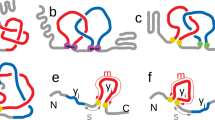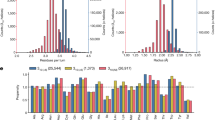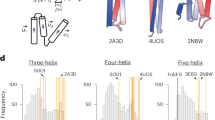Abstract
β- Hairpins, one of the simplest supersecondary structures, are widespread in globular proteins, and have often been suggested as possible sites for nucleation1. Here we consider the conformation and sequences of the loop regions of β-hairpins by analysing proteins of known structure. We find that the ‘tight’ β- hairpins, classified by the length and conformations of their loop regions, form distinct families and that the loop regions of the family members have sequences which are characteristic of that family. The two-residue hairpin loops include almost entirely I′ or II′ β-turns, in contrast to the general preference for type I and type II turns2,3. These findings are being used to help define templates or consensus sequences to be incorporated into our existing super-secondary structure prediction algorithm4,5. This information can also be used in model-building homologous proteins.
This is a preview of subscription content, access via your institution
Access options
Subscribe to this journal
Receive 51 print issues and online access
$199.00 per year
only $3.90 per issue
Buy this article
- Purchase on Springer Link
- Instant access to full article PDF
Prices may be subject to local taxes which are calculated during checkout
Similar content being viewed by others
References
Ptitsyn, O. B. FEBS Lett. 131, 197–202 (1981).
Chou, P. Y. & Fasman, G. D. J. molec. Biol. 115, 135–175 (1977).
Lewis, P. N., Momany, F. A. & Scheraga, H. A. Biochim. biophys. Acta 303, 211–229 (1973).
Taylor, W. R. & Thornton, J. M. Nature 301, 540–542 (1983).
Taylor, W. R. & Thornton, J. M. J. molec. Biol. 173, 487–514 (1984).
Kabsch, W. & Sander, C. Biopolymers 22, 2577–2637 (1984).
Chothia, C. J. molec. Biol. 75, 295–302 (1973).
Nemethy, G. & Scheraga, H. A. Q. Rev. Biophys. 10, 239–352 (1977).
Richardson, J. S., Getzoff, E. D. & Richardson, D. C. Proc. natn. Acad. Sci. U.S.A. 75, 2574–2578 (1978).
Greer, J. J molec. Biol. 153, 1027–1042 (1981).
Sibanda, B. L. et al. FEBS Lett. 174, 103–111 (1984).
Sternberg, M. J. E. & Thornton, J. M. J molec. Biol. 115, 1–17 (1977).
Argos, P., Rossmann, M. G. & Johnson, J. E. Biochem. biophys. Res. Commun. 75, 83–86 (1977).
Efimov, A. V. FEBS Lett. 166, 33–38 (1984).
Bernstein, F. C. et al. J. molec. Biol. 122, 535–542 (1977).
Richardson, J. S. Adv. Protein Chem. 34, 167–339 (1981).
Isogai, Y., Nemethy, G., Rackovsky, S., Leach, J. S. & Scheraga, H. A. Biopolymers 19, 1183–1210 (1980).
Author information
Authors and Affiliations
Rights and permissions
About this article
Cite this article
Sibanda, B., Thornton, J. β-Hairpin families in globular proteins. Nature 316, 170–174 (1985). https://doi.org/10.1038/316170a0
Received:
Accepted:
Issue Date:
DOI: https://doi.org/10.1038/316170a0
This article is cited by
-
Enhancing fragment-based protein structure prediction by customising fragment cardinality according to local secondary structure
BMC Bioinformatics (2020)
-
An intermolecular disulfide bond is required for thermostability and thermoactivity of β-glycosidase from Thermococcus kodakarensis KOD1
Applied Microbiology and Biotechnology (2014)
-
Mining protein loops using a structural alphabet and statistical exceptionality
BMC Bioinformatics (2010)
-
Creating novel protein scripts beyond natural alphabets
Systems and Synthetic Biology (2010)
-
MSDmotif: exploring protein sites and motifs
BMC Bioinformatics (2008)
Comments
By submitting a comment you agree to abide by our Terms and Community Guidelines. If you find something abusive or that does not comply with our terms or guidelines please flag it as inappropriate.



